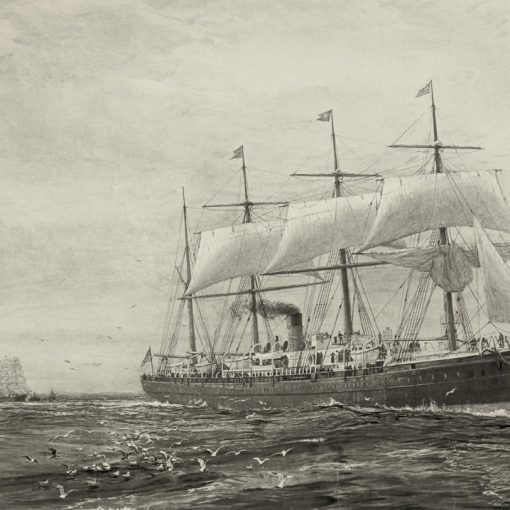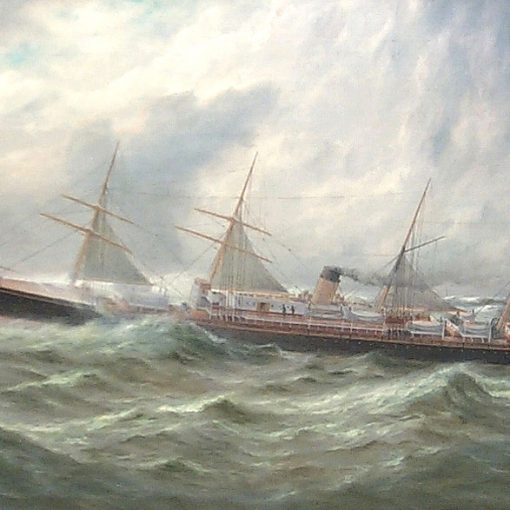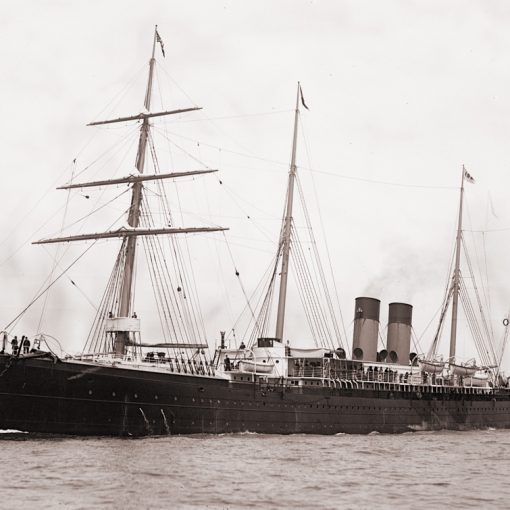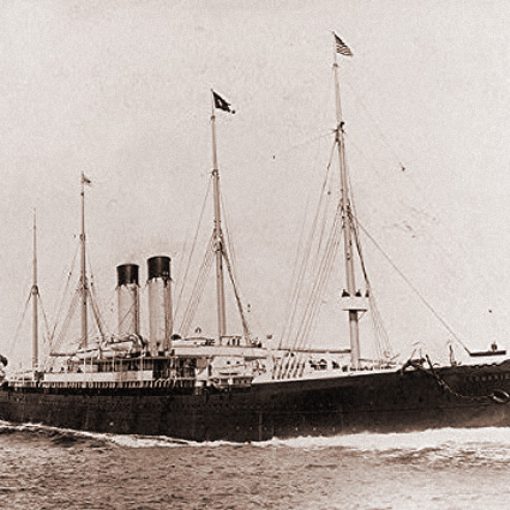1909 – 1933
In 1907, the Cunard Line had introduced two new astounding ocean liners named Lusitania and Mauretania. They became known as the largest, fastest and most luxurious passenger liners afloat. With a service speed in the vicinity of 25 knots, the two ships captured the Blue Riband of the Atlantic from the German liners Kaiser Wilhelm II and Deutschland.
With Cunard stealing all the glory, the British rival White Star Line, wanted its share as well. They started to plan for two new ships that would outmatch Lusitania and Mauretania in size and luxury, but not in speed. If the first two ships were successful, they would be followed by a third. Of course, these ships were the Olympic, Titanic and Britannic. With a gross tonnage of roughly 45,000 tons, they would beat the Cunarders with 15,000 tons.
Lusitania and Mauretania owed the Blue Riband to their spectacular machinery. Instead of the conventional triple or quadruple expansion engines, Cunard had invested its money in the new turbine engines. This type of machinery gave the two liners 68,000 horsepower. If they had been equipped with expansion engines, it is possible that they would not have taken the Blue Riband from the Germans.
With the success of turbine power for Cunard, White Star thought they also needed a new type of engines for their new liners. The previous prime ships of the line – the Celtic, Cedric, Baltic and Adriatic – had all been equipped with two screws and expansion engines, but to the cost of a fairly low service speed at 16 knots. However, they were very reliable, and the North Atlantic passengers enjoyed these comfortable ships.
White Star Line did not go as far as to decide on genuine turbine engines straight away. They saw two choices – either would they have the conventional expansion engines with two screws fitted into the Olympic-class, or they would invest in a combined sort of engine with triple expansion engines that powered a turbine engine with excess steam. The expansion engines would turn two wing propellers, while a centre propeller would be powered by the turbine. But before inserting one of the choices into the ships straight away, White Star needed to test the two engine types against each other.
In 1907 and 1908, the Dominion Line had laid down two almost identical liners – the Alberta and the Albany. The Alberta was fitted with the combined engine type and propellers White Star were considering for the Olympic-class, while the Albany was fitted with the conventional expansion engines and a mere two screws. These liners were built for the Dominion Line in order to match the Allan Line and Canadian Pacific competition.
White Star immediately saw the opportunity in the two Dominion liners. By the time of the ships’ launching, they had both been bought by the larger company to be used on the White Star-Dominion joint service to Canada. The Alberta was renamed Laurentic and the Albany was renamed Megantic. Now, these two ships were to be tested against each other to help White Star decide what engines to use on the forthcoming giants.
The Laurentic had been launched in September 1908, and went out on her premiere crossing in late April 1909. The Megantic was launched in December 1908 and was delivered to White Star on June 3, 1909. She crossed from Liverpool to Montreal on her maiden voyage on June 17.
With both ships now in service, White Star could compare them. The superior ship was without doubt the Laurentic. She had approximately the same service speed – 17 knots – as the Megantic, but at a lower cost. White Star made the final decision and chose the new combined triple expansion/turbine-type of machinery for the Olympic-class.
However, the Megantic was not to be rebuilt with the superior engine type. In order to do that, her whole stern frame would have to be replaced. In any case, she was perfectly satisfactory, and continued her duties without problems.
In 1910, one of the most hated criminals in Britain – the wife killer Dr. Crippen and lover Ethel le Néve – had fled to Canada on Canadian Pacific’s Montrose. Since Crippen was an American citizen, he would be outside of British jurisdiction if her stepped ashore in North America. However, the crew on board the Montrose became suspicious and wirelessed Scotland Yard about Crippen’s presence. One Inspector Dew booked a ticket on the Laurentic – who was the fastest ship on the Canadian run along with the Megantic – and managed to catch up with the Montrose off Father Point, St. Lawrence. The Montrose let the inspector on board and Dr. Crippen was arrested. He was taken care of by the police, and later returned to Britain to stand trial on no other ship than the Megantic. For his criminal deeds, Dr. Crippen was hanged.
In 1914, the First World War erupted. Many liners were taken in by the Admiralty to assist in the war at sea. The Megantic was used for trooping duties as early as October 3, 1914 when she participated in the famed 32 trooper convoy from Gaspé to Plymouth. The convoy was escorted by the warships Charybdis, Diane, Eclipse, Glory and Talbot. Megantic was in the White Squadron section along with the Bermudian, Royal Edward and Franconia. On October 14, the Megantic had carried out her duty flawlessly, and lay anchored off Devonport. On November 30, she was again placed on the North Atlantic run, between Liverpool and New York.
In April 1915, the Admiralty once again requested the Megantic’s assistance. She would, yet again, act as a troop ship. The limit of soldiers on board was set to 1,800 men. The Megantic stayed in this guise for another two years. On February 24, the ship was lucky enough to escape a torpedo from the German submarine UB-43. In April of that year, Megantic was taken over in accordance with the Liner Requisition Scheme.
Only a few months after the war had ended, the Megantic was returned to civilian service. On December 11, 1918 she made her first post war sailing between Liverpool and New York. In 1919, the liner was refitted at Belfast and emerged with a slightly altered passenger accommodation capacity. First class was changed from 230 to 325, second from 430 to 260 and third from 1,000 to 550. After the refit, the Megantic was returned to the Canadian service. Her consort became the Canada who replaced the Laurentic, who tragically had been lost to German mines in 1917. In the off season, Megantic was sent cruising in the West Indies.
In January 1920, the Megantic made one sailing for the White Star-Shaw, Savill & Albion joint service, and later that year she made a voyage in Government service with some of its staff to Sydney and Wellington. In 1924, the ship was converted into a Cabin Class liner – the new passenger accommodation was 452 cabin class and the same as before in second and third classes.
In 1927, Megantic was charted for a trooping voyage to Shanghai, and in late March the following year she was put on the London-Le Havre-Halifax-New York service until the St. Lawrence opened – then her destination became Québec and Montreal. In 1930 and 1931, the ageing liner was used on economy cruises with Adriatic, Calgaric and the new Laurentic. In May 1931, she was returned to the liner service between Liverpool and Montreal. In July she was laid up Rothesay Bay.
With the poor financial situation in the world in the early Thirties, it became less and less likely for the Megantic to return to service. She was, after all, 22 years old. She remained laid up until February 1933, when she steamed out of Rothesay Bay under her own power, bound for Osaka where she would be broken up.
Specifications
- 565 feet (172.6 m) long
- 67.3 feet (20.6 m) wide
- 14,878 gross tons
- Quadruple-expansion engines powering two propellers
- 16.5 knot service speed
- Passenger capacity of 1,690 people









2 thoughts on “Megantic”
Not sure if this site is still actively monitered, but I found it on a google search. I have an old photo album with some photos the family has labeled “On board SS Megantic 1910.” If someone is interested in seeing them, I’ll happily send a pic of the photos.
Hi Molly, I also googled Megantic and found you. I’m looking for a Tom Gillison who was on board this ship 1910/1911 would live to see a picture.
Would love to see some pics